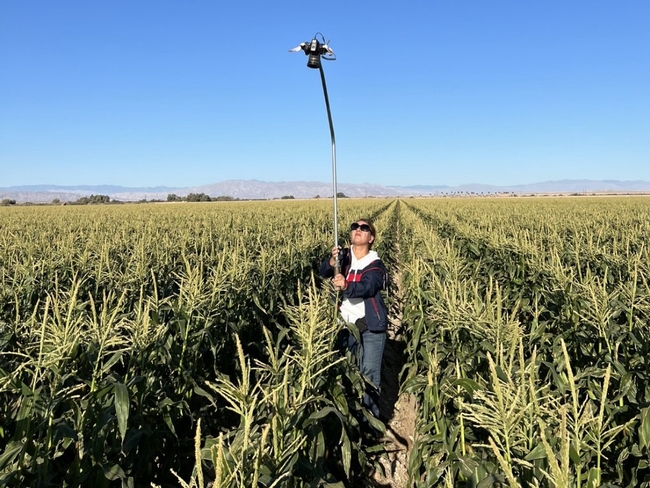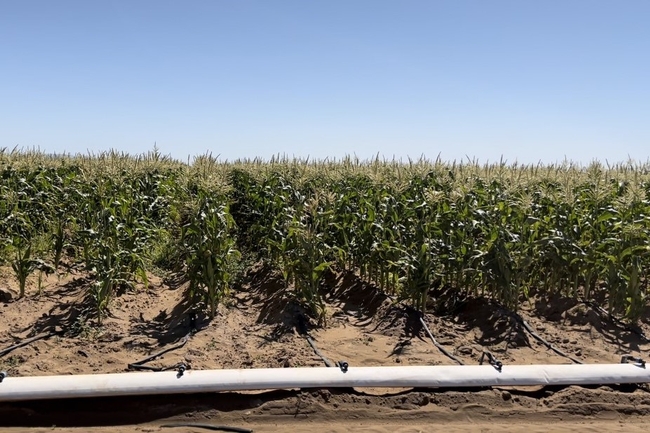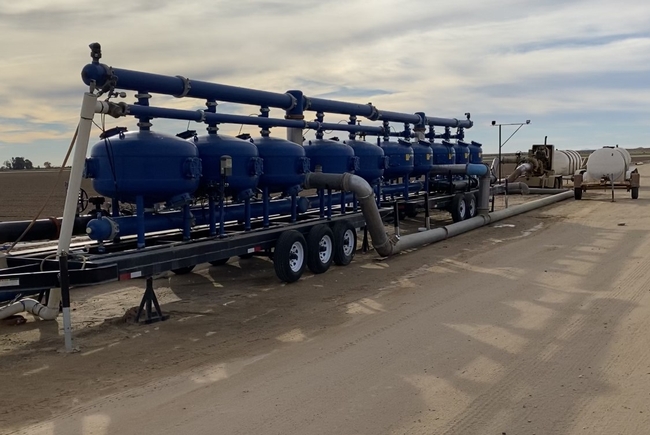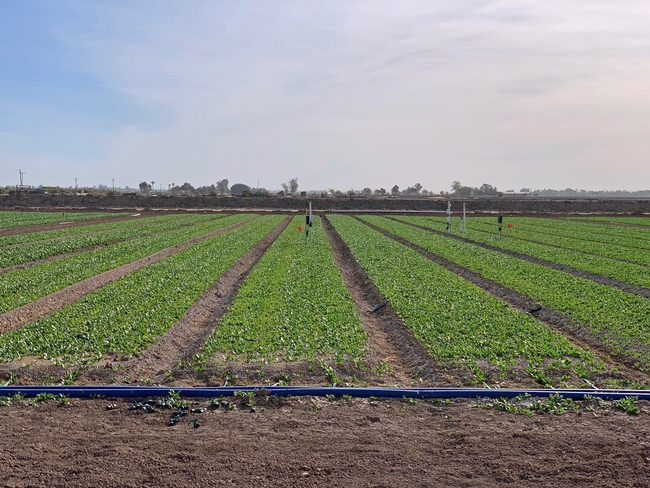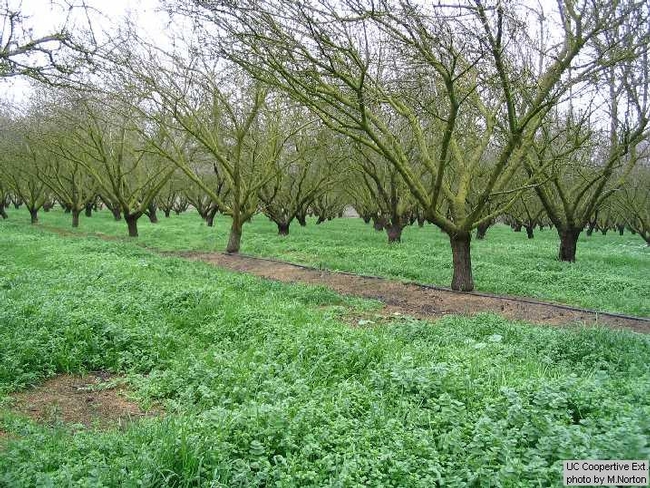Posts Tagged: drip
Drip-irrigation study sees ‘huge’ reduction in water, fertilizer use for sweet corn
Study by UCCE advisor in Imperial County also shows 5% increase in yield
A new study suggests that drip irrigation for sweet corn can significantly conserve water, reduce fertilizer use and boost crop yield in the low desert of California – and likely in other areas of California with similar conditions.
Although Imperial County is California's top sweet corn-producing county, with about 8,000 acres planted on average each year, irrigation methods for this crop have been rarely studied in this region (or anywhere else in the state), according to Ali Montazar, UC Cooperative Extension irrigation and water management advisor for Imperial, Riverside and San Diego counties.
Montazar conducted a study in the Imperial Valley over two crop seasons, 2020-21 and 2021-22, to demonstrate and quantify the potential benefits of switching to drip irrigation from the more common furrow irrigation method. The study, available in a recent issue of UC Agriculture and Natural Resources' Agricultural Briefs, will be published in a future issue of Vegetables West.
“I'm hoping with this project we can encourage growers to adopt it, because it seems very promising,” said Montazar, noting that drip irrigation is a “new practice” for sweet corn in California.
Among the 11 commercial sweet corn fields in the study over the 2021-22 season, the six that were under drip irrigation used, on average, 37% less water than the five under furrow irrigation. In absolute terms, the drip-irrigated fields saw an average water savings of 2.2 acre-feet per acre; for Montazar, who has studied drip for a variety of crops in the Imperial Valley, that was an astonishing result.
“I've worked with drip on processed onions, lettuce, alfalfa, spinach … we've never seen a figure like 2.2 acre-feet per acre, that's huge,” he said, attributing the dramatic drop-off to the high volume of water required to furrow-irrigate the sandy soil in the Imperial Valley.
More efficient irrigation also means less fertilizer is needed – a boon to the environment and Salton Sea water quality, as well as growers' bottom line. With fertilizer prices continuing to rise, sweet corn growers using drip could see a substantial 25% cost savings on fertilizer expenses – about $150 per acre less – compared to furrow irrigation, according to Montazar's study.
And by relieving plants of the stress from over- and under-irrigated conditions, drip irrigation helps keep soil moisture at its “sweet spot” – resulting in a 5% increase in marketable crop yield for sweet corn in the study.
“When we have a better, more efficient irrigation system, we can maintain soil moisture at a desired level, over time and space,” Montazar explained.
Because the benefits of drip appear to be linked to soil conditions (sandy loam, and other light soils), Montazar believes that this irrigation practice could deliver relatively similar water and fertilizer savings and improved crop yield in other regions across California, regardless of climactic differences.
“If you use drip in any part of the state, you have the benefits of drip – more uniform water application, more uniform fertilizer – that's not related to the desert,” he said. “That's part of the system's potential.”
Montazar plans to follow up on his preliminary study with additional research on sweet corn and drip irrigation during the 2022-23 crop season.
Drip irrigation continues to yield benefits
Considered among the most important agricultural innovations in the world, drip irrigation has been researched for decades. UC Cooperative Extension weed management advisor Aliasghar Montazar has taken a close look at its application in organic spinach cultivation, reported Matthew Grassi in Growing Produce.
Not only does drip irrigation use less water than irrigation with sprinklers, the slow emission of water near plant roots also diminishes the crops' susceptibility to disease. Growers believe that ongoing issues with downy mildew is at least partially caused by moisture that sprinklers leave in the plant canopy.
“Being certified organic, there is really nothing they can use as fungicide; so it is a big problem,” Montazar said. “So, we said ‘Let's try drip (irrigation) in spinach.'”
Early results are promising. Montazar has analyzed enough field data from the plots to directly correlate a four- to five-times reduction in downy mildew disease in plots grown with drip irrigation compared to sprinkler-irrigated plots.
“The other thing to note is there is a nice savings on energy as well,” Montazar said. “Another grower reported he saved $200 an acre on energy savings from getting off the sprinklers. Because with drip, there is less pressure needed, so it consumes less energy (to pump water).”
Flood irrigation may help recharge aquifers
UC Agriculture and Natural Resources experts are studying the effectiveness of flood irrigation to help recharge underground aquifers that have been depleted due to the drought, reported Ken Carlson in the Modesto Bee.
The pilot research project will involve flood irrigating almond orchards during the winter months, according to Roger Duncan, UC ANR Cooperative Extension advisor in Stanislaus County.
"If it works well, we can expand and potentially look at other locations, other soil types and other cropping systems," Duncan said.
The Modesto trial will take place on one orchard with 10 to 15 acres of fairly sandy soil with groundwater from another area.
According to the article, commercial almond orchards are not usually irrigated in winter because there's enough rainfall to keep the ground moist. Flood irrigation in almonds has of late been regarded as a wasteful practice from the era of cheap and plentiful water; many farmers have turned to micro sprinklers and drip irrigation for water conservation. But orchard flooding could bounce back as a strategic tool as local jurisdictions try to manage their groundwater levels.
How does your garden grow? In a drought, consider drip
Mary, Mary, quite contrary
How does your garden grow?
--English nursery rhyme
How will your garden grow during California’s drought emergency? Gov. Jerry Brown says the state is facing the worst drought in its recorded history.
We urban gardeners may turn quite contrary if our gardens don't grow.
Alternative: Consider installing a drip irrigation system.
Why a drip system? It’s target watering. It’s uniform watering. It’s non-wasteful watering. You don’t want to water the leaves, the space between the plants, or worse, water the sidewalk or let the water gush into the gutter.
Drip irrigation is better for plant health. Plants thrive with drip because it waters them slow and deep where the roots are. You’ll likely minimize weed growth. In comparison to overhead sprinklers, the smaller, targeted area means that weeds will have less opportunity to spring up and try to take over your garden, Gangnam Style. And by not watering the leaves of your plants or allow them to collect standing water, you can reduce diseases.
Drip irrigation is simply a network of pipes, tubing, valves and emitters. Water “drips” or “trickles” directly to the roots.
The concept is not new. Back in the first century, Fan Sheng-Chih Shu wrote about what we now consider a “primitive” drip irrigation system, but one that definitely worked well: Farmers buried perforated unglazed clay pots and filled them with water. They refilled them as needed.
Today’s modern drip irrigation system for urban gardeners includes an irrigation controller with automatic valves or a manual system (shown). If it's automatic, a timer controls the valves and waters the plants while you do something else - like enjoying a glass of lemonade on the back porch, watching your favorite movie, or vacationing in Hawaii. Note: It's a good idea to set your timer for early in the morning, before 8. There's less evaporation.
Of course, there can be disadvantages to the drip system. The key disadvantages are the initial cost of the equipment and labor. Then, too, you must closely monitor the system to ensure the emitters aren’t clogged, or thirsty rodents aren’t gnawing through your plastic pipes.
Find more about drip irrigation on the Sonoma County Master Gardeners website.
Bottom line: A drip irrigation system is often a better alternative to overhead sprinklers or the hand-watering method. Expect to conserve water, save on your water bill, grow healthy plants with fewer weeds and diseases, and save time and effort in doing so.

An artichoke in the drip grid. This area is ready for planting. (Photo by Kathy Keatley Garvey)

A newly planted peach tree among the drip lines. (Photo by Kathy Keatley Garvey)

Corners of the drip grid. (Photo by Kathy Keatley Garvey)

